East West MRT line
The East West line (EWL) is a high-capacity Mass Rapid Transit (MRT) line operated by SMRT, running from Pasir Ris station in the east to Tuas Link station in the west, with an additional branch between Changi Airport and Tanah Merah stations. It is the second Mass Rapid Transit line to be built in Singapore. The 57.2 kilometres (35.5 mi) line is the longest on the MRT network, with 35 stations, 8 of which (from Lavender to Tiong Bahru and Changi Airport stations) are underground.[1] The line is coloured green on the rail map.
East West line | ||||||||||||||||||||||||||||||||||||||||||||||||||||||||||||||||||||||||||||||||||||||||||||||||||||||||||||||||||||||||||||||||||||||||||||||||||||||||||||||||||||||||||||||||||||||||||||||||||||||||||||||||||||||||||||||||||||||||||||||||||||||||||||||||||||||||||||||||||||||||||||||||||||||||||||||||||||||||||||||||||||||||||||||||||||||||||||||||||||||||||||||||||||||||||||||||||||||||||||||||||||||||||||||||||||||||||||||||||||||||||||||||||||||||||||||||||||||||||||||||||||||||||||||||||||||||||||||||||
|---|---|---|---|---|---|---|---|---|---|---|---|---|---|---|---|---|---|---|---|---|---|---|---|---|---|---|---|---|---|---|---|---|---|---|---|---|---|---|---|---|---|---|---|---|---|---|---|---|---|---|---|---|---|---|---|---|---|---|---|---|---|---|---|---|---|---|---|---|---|---|---|---|---|---|---|---|---|---|---|---|---|---|---|---|---|---|---|---|---|---|---|---|---|---|---|---|---|---|---|---|---|---|---|---|---|---|---|---|---|---|---|---|---|---|---|---|---|---|---|---|---|---|---|---|---|---|---|---|---|---|---|---|---|---|---|---|---|---|---|---|---|---|---|---|---|---|---|---|---|---|---|---|---|---|---|---|---|---|---|---|---|---|---|---|---|---|---|---|---|---|---|---|---|---|---|---|---|---|---|---|---|---|---|---|---|---|---|---|---|---|---|---|---|---|---|---|---|---|---|---|---|---|---|---|---|---|---|---|---|---|---|---|---|---|---|---|---|---|---|---|---|---|---|---|---|---|---|---|---|---|---|---|---|---|---|---|---|---|---|---|---|---|---|---|---|---|---|---|---|---|---|---|---|---|---|---|---|---|---|---|---|---|---|---|---|---|---|---|---|---|---|---|---|---|---|---|---|---|---|---|---|---|---|---|---|---|---|---|---|---|---|---|---|---|---|---|---|---|---|---|---|---|---|---|---|---|---|---|---|---|---|---|---|---|---|---|---|---|---|---|---|---|---|---|---|---|---|---|---|---|---|---|---|---|---|---|---|---|---|---|---|---|---|---|---|---|---|---|---|---|---|---|---|---|---|---|---|---|---|---|---|---|---|---|---|---|---|---|---|---|---|---|---|---|---|---|---|---|---|---|---|---|---|---|---|---|---|---|---|---|---|---|---|---|---|---|---|---|---|---|---|---|---|---|---|---|---|---|---|---|---|---|---|---|---|---|---|---|---|---|---|---|---|---|---|---|---|---|---|---|---|---|---|---|---|---|---|---|---|---|---|---|---|---|---|---|---|---|---|---|---|---|---|---|---|---|---|---|---|---|---|---|---|---|---|---|---|---|---|---|---|---|---|---|---|---|---|---|---|---|---|---|---|---|---|---|---|---|---|---|---|---|---|---|---|---|---|---|---|---|---|---|---|---|---|---|---|---|---|---|---|---|---|---|
 A C151B train at Tuas Link MRT station | ||||||||||||||||||||||||||||||||||||||||||||||||||||||||||||||||||||||||||||||||||||||||||||||||||||||||||||||||||||||||||||||||||||||||||||||||||||||||||||||||||||||||||||||||||||||||||||||||||||||||||||||||||||||||||||||||||||||||||||||||||||||||||||||||||||||||||||||||||||||||||||||||||||||||||||||||||||||||||||||||||||||||||||||||||||||||||||||||||||||||||||||||||||||||||||||||||||||||||||||||||||||||||||||||||||||||||||||||||||||||||||||||||||||||||||||||||||||||||||||||||||||||||||||||||||||||||||||||||
| Overview | ||||||||||||||||||||||||||||||||||||||||||||||||||||||||||||||||||||||||||||||||||||||||||||||||||||||||||||||||||||||||||||||||||||||||||||||||||||||||||||||||||||||||||||||||||||||||||||||||||||||||||||||||||||||||||||||||||||||||||||||||||||||||||||||||||||||||||||||||||||||||||||||||||||||||||||||||||||||||||||||||||||||||||||||||||||||||||||||||||||||||||||||||||||||||||||||||||||||||||||||||||||||||||||||||||||||||||||||||||||||||||||||||||||||||||||||||||||||||||||||||||||||||||||||||||||||||||||||||||
| Native name | Laluan MRT Timur Barat 东西地铁线 கிழக்கு மேற்கு எம்ஆர்டி வழி | |||||||||||||||||||||||||||||||||||||||||||||||||||||||||||||||||||||||||||||||||||||||||||||||||||||||||||||||||||||||||||||||||||||||||||||||||||||||||||||||||||||||||||||||||||||||||||||||||||||||||||||||||||||||||||||||||||||||||||||||||||||||||||||||||||||||||||||||||||||||||||||||||||||||||||||||||||||||||||||||||||||||||||||||||||||||||||||||||||||||||||||||||||||||||||||||||||||||||||||||||||||||||||||||||||||||||||||||||||||||||||||||||||||||||||||||||||||||||||||||||||||||||||||||||||||||||||||||||
| Type | Rapid transit | |||||||||||||||||||||||||||||||||||||||||||||||||||||||||||||||||||||||||||||||||||||||||||||||||||||||||||||||||||||||||||||||||||||||||||||||||||||||||||||||||||||||||||||||||||||||||||||||||||||||||||||||||||||||||||||||||||||||||||||||||||||||||||||||||||||||||||||||||||||||||||||||||||||||||||||||||||||||||||||||||||||||||||||||||||||||||||||||||||||||||||||||||||||||||||||||||||||||||||||||||||||||||||||||||||||||||||||||||||||||||||||||||||||||||||||||||||||||||||||||||||||||||||||||||||||||||||||||||
| System | Mass Rapid Transit (Singapore) | |||||||||||||||||||||||||||||||||||||||||||||||||||||||||||||||||||||||||||||||||||||||||||||||||||||||||||||||||||||||||||||||||||||||||||||||||||||||||||||||||||||||||||||||||||||||||||||||||||||||||||||||||||||||||||||||||||||||||||||||||||||||||||||||||||||||||||||||||||||||||||||||||||||||||||||||||||||||||||||||||||||||||||||||||||||||||||||||||||||||||||||||||||||||||||||||||||||||||||||||||||||||||||||||||||||||||||||||||||||||||||||||||||||||||||||||||||||||||||||||||||||||||||||||||||||||||||||||||
| Status | Operational | |||||||||||||||||||||||||||||||||||||||||||||||||||||||||||||||||||||||||||||||||||||||||||||||||||||||||||||||||||||||||||||||||||||||||||||||||||||||||||||||||||||||||||||||||||||||||||||||||||||||||||||||||||||||||||||||||||||||||||||||||||||||||||||||||||||||||||||||||||||||||||||||||||||||||||||||||||||||||||||||||||||||||||||||||||||||||||||||||||||||||||||||||||||||||||||||||||||||||||||||||||||||||||||||||||||||||||||||||||||||||||||||||||||||||||||||||||||||||||||||||||||||||||||||||||||||||||||||||
| Locale | Singapore | |||||||||||||||||||||||||||||||||||||||||||||||||||||||||||||||||||||||||||||||||||||||||||||||||||||||||||||||||||||||||||||||||||||||||||||||||||||||||||||||||||||||||||||||||||||||||||||||||||||||||||||||||||||||||||||||||||||||||||||||||||||||||||||||||||||||||||||||||||||||||||||||||||||||||||||||||||||||||||||||||||||||||||||||||||||||||||||||||||||||||||||||||||||||||||||||||||||||||||||||||||||||||||||||||||||||||||||||||||||||||||||||||||||||||||||||||||||||||||||||||||||||||||||||||||||||||||||||||
| Termini | Pasir Ris Changi Airport (Until 2040) Tanah Merah (Until 2040) Tuas Link | |||||||||||||||||||||||||||||||||||||||||||||||||||||||||||||||||||||||||||||||||||||||||||||||||||||||||||||||||||||||||||||||||||||||||||||||||||||||||||||||||||||||||||||||||||||||||||||||||||||||||||||||||||||||||||||||||||||||||||||||||||||||||||||||||||||||||||||||||||||||||||||||||||||||||||||||||||||||||||||||||||||||||||||||||||||||||||||||||||||||||||||||||||||||||||||||||||||||||||||||||||||||||||||||||||||||||||||||||||||||||||||||||||||||||||||||||||||||||||||||||||||||||||||||||||||||||||||||||
| Stations | 35 | |||||||||||||||||||||||||||||||||||||||||||||||||||||||||||||||||||||||||||||||||||||||||||||||||||||||||||||||||||||||||||||||||||||||||||||||||||||||||||||||||||||||||||||||||||||||||||||||||||||||||||||||||||||||||||||||||||||||||||||||||||||||||||||||||||||||||||||||||||||||||||||||||||||||||||||||||||||||||||||||||||||||||||||||||||||||||||||||||||||||||||||||||||||||||||||||||||||||||||||||||||||||||||||||||||||||||||||||||||||||||||||||||||||||||||||||||||||||||||||||||||||||||||||||||||||||||||||||||
| Services | 2 | |||||||||||||||||||||||||||||||||||||||||||||||||||||||||||||||||||||||||||||||||||||||||||||||||||||||||||||||||||||||||||||||||||||||||||||||||||||||||||||||||||||||||||||||||||||||||||||||||||||||||||||||||||||||||||||||||||||||||||||||||||||||||||||||||||||||||||||||||||||||||||||||||||||||||||||||||||||||||||||||||||||||||||||||||||||||||||||||||||||||||||||||||||||||||||||||||||||||||||||||||||||||||||||||||||||||||||||||||||||||||||||||||||||||||||||||||||||||||||||||||||||||||||||||||||||||||||||||||
| Operation | ||||||||||||||||||||||||||||||||||||||||||||||||||||||||||||||||||||||||||||||||||||||||||||||||||||||||||||||||||||||||||||||||||||||||||||||||||||||||||||||||||||||||||||||||||||||||||||||||||||||||||||||||||||||||||||||||||||||||||||||||||||||||||||||||||||||||||||||||||||||||||||||||||||||||||||||||||||||||||||||||||||||||||||||||||||||||||||||||||||||||||||||||||||||||||||||||||||||||||||||||||||||||||||||||||||||||||||||||||||||||||||||||||||||||||||||||||||||||||||||||||||||||||||||||||||||||||||||||||
| Opened | 12 December 1987 (as part of North South line) 4 November 1989 (renamed as East West line) | |||||||||||||||||||||||||||||||||||||||||||||||||||||||||||||||||||||||||||||||||||||||||||||||||||||||||||||||||||||||||||||||||||||||||||||||||||||||||||||||||||||||||||||||||||||||||||||||||||||||||||||||||||||||||||||||||||||||||||||||||||||||||||||||||||||||||||||||||||||||||||||||||||||||||||||||||||||||||||||||||||||||||||||||||||||||||||||||||||||||||||||||||||||||||||||||||||||||||||||||||||||||||||||||||||||||||||||||||||||||||||||||||||||||||||||||||||||||||||||||||||||||||||||||||||||||||||||||||
| Owner | Land Transport Authority | |||||||||||||||||||||||||||||||||||||||||||||||||||||||||||||||||||||||||||||||||||||||||||||||||||||||||||||||||||||||||||||||||||||||||||||||||||||||||||||||||||||||||||||||||||||||||||||||||||||||||||||||||||||||||||||||||||||||||||||||||||||||||||||||||||||||||||||||||||||||||||||||||||||||||||||||||||||||||||||||||||||||||||||||||||||||||||||||||||||||||||||||||||||||||||||||||||||||||||||||||||||||||||||||||||||||||||||||||||||||||||||||||||||||||||||||||||||||||||||||||||||||||||||||||||||||||||||||||
| Operator(s) | SMRT Trains (SMRT Corporation) | |||||||||||||||||||||||||||||||||||||||||||||||||||||||||||||||||||||||||||||||||||||||||||||||||||||||||||||||||||||||||||||||||||||||||||||||||||||||||||||||||||||||||||||||||||||||||||||||||||||||||||||||||||||||||||||||||||||||||||||||||||||||||||||||||||||||||||||||||||||||||||||||||||||||||||||||||||||||||||||||||||||||||||||||||||||||||||||||||||||||||||||||||||||||||||||||||||||||||||||||||||||||||||||||||||||||||||||||||||||||||||||||||||||||||||||||||||||||||||||||||||||||||||||||||||||||||||||||||
| Character | Elevated (Pasir Ris - Kallang, Redhill - Tuas Link, Expo) Underground (Lavender - Tiong Bahru, Changi Airport) | |||||||||||||||||||||||||||||||||||||||||||||||||||||||||||||||||||||||||||||||||||||||||||||||||||||||||||||||||||||||||||||||||||||||||||||||||||||||||||||||||||||||||||||||||||||||||||||||||||||||||||||||||||||||||||||||||||||||||||||||||||||||||||||||||||||||||||||||||||||||||||||||||||||||||||||||||||||||||||||||||||||||||||||||||||||||||||||||||||||||||||||||||||||||||||||||||||||||||||||||||||||||||||||||||||||||||||||||||||||||||||||||||||||||||||||||||||||||||||||||||||||||||||||||||||||||||||||||||
| Depot(s) | Ulu Pandan Tuas Changi East Coast (Future) | |||||||||||||||||||||||||||||||||||||||||||||||||||||||||||||||||||||||||||||||||||||||||||||||||||||||||||||||||||||||||||||||||||||||||||||||||||||||||||||||||||||||||||||||||||||||||||||||||||||||||||||||||||||||||||||||||||||||||||||||||||||||||||||||||||||||||||||||||||||||||||||||||||||||||||||||||||||||||||||||||||||||||||||||||||||||||||||||||||||||||||||||||||||||||||||||||||||||||||||||||||||||||||||||||||||||||||||||||||||||||||||||||||||||||||||||||||||||||||||||||||||||||||||||||||||||||||||||||
| Rolling stock | C151 C651 C751B C151A C151B CR151 (Future) | |||||||||||||||||||||||||||||||||||||||||||||||||||||||||||||||||||||||||||||||||||||||||||||||||||||||||||||||||||||||||||||||||||||||||||||||||||||||||||||||||||||||||||||||||||||||||||||||||||||||||||||||||||||||||||||||||||||||||||||||||||||||||||||||||||||||||||||||||||||||||||||||||||||||||||||||||||||||||||||||||||||||||||||||||||||||||||||||||||||||||||||||||||||||||||||||||||||||||||||||||||||||||||||||||||||||||||||||||||||||||||||||||||||||||||||||||||||||||||||||||||||||||||||||||||||||||||||||||
| Technical | ||||||||||||||||||||||||||||||||||||||||||||||||||||||||||||||||||||||||||||||||||||||||||||||||||||||||||||||||||||||||||||||||||||||||||||||||||||||||||||||||||||||||||||||||||||||||||||||||||||||||||||||||||||||||||||||||||||||||||||||||||||||||||||||||||||||||||||||||||||||||||||||||||||||||||||||||||||||||||||||||||||||||||||||||||||||||||||||||||||||||||||||||||||||||||||||||||||||||||||||||||||||||||||||||||||||||||||||||||||||||||||||||||||||||||||||||||||||||||||||||||||||||||||||||||||||||||||||||||
| Line length | 57.2 km (35.5 mi) | |||||||||||||||||||||||||||||||||||||||||||||||||||||||||||||||||||||||||||||||||||||||||||||||||||||||||||||||||||||||||||||||||||||||||||||||||||||||||||||||||||||||||||||||||||||||||||||||||||||||||||||||||||||||||||||||||||||||||||||||||||||||||||||||||||||||||||||||||||||||||||||||||||||||||||||||||||||||||||||||||||||||||||||||||||||||||||||||||||||||||||||||||||||||||||||||||||||||||||||||||||||||||||||||||||||||||||||||||||||||||||||||||||||||||||||||||||||||||||||||||||||||||||||||||||||||||||||||||
| Track gauge | 1,435 mm (4 ft 8 1⁄2 in) standard gauge | |||||||||||||||||||||||||||||||||||||||||||||||||||||||||||||||||||||||||||||||||||||||||||||||||||||||||||||||||||||||||||||||||||||||||||||||||||||||||||||||||||||||||||||||||||||||||||||||||||||||||||||||||||||||||||||||||||||||||||||||||||||||||||||||||||||||||||||||||||||||||||||||||||||||||||||||||||||||||||||||||||||||||||||||||||||||||||||||||||||||||||||||||||||||||||||||||||||||||||||||||||||||||||||||||||||||||||||||||||||||||||||||||||||||||||||||||||||||||||||||||||||||||||||||||||||||||||||||||
| Electrification | 750 V DC Third rail | |||||||||||||||||||||||||||||||||||||||||||||||||||||||||||||||||||||||||||||||||||||||||||||||||||||||||||||||||||||||||||||||||||||||||||||||||||||||||||||||||||||||||||||||||||||||||||||||||||||||||||||||||||||||||||||||||||||||||||||||||||||||||||||||||||||||||||||||||||||||||||||||||||||||||||||||||||||||||||||||||||||||||||||||||||||||||||||||||||||||||||||||||||||||||||||||||||||||||||||||||||||||||||||||||||||||||||||||||||||||||||||||||||||||||||||||||||||||||||||||||||||||||||||||||||||||||||||||||
| Operating speed | limited to 80 km/h (50 mph) | |||||||||||||||||||||||||||||||||||||||||||||||||||||||||||||||||||||||||||||||||||||||||||||||||||||||||||||||||||||||||||||||||||||||||||||||||||||||||||||||||||||||||||||||||||||||||||||||||||||||||||||||||||||||||||||||||||||||||||||||||||||||||||||||||||||||||||||||||||||||||||||||||||||||||||||||||||||||||||||||||||||||||||||||||||||||||||||||||||||||||||||||||||||||||||||||||||||||||||||||||||||||||||||||||||||||||||||||||||||||||||||||||||||||||||||||||||||||||||||||||||||||||||||||||||||||||||||||||
| ||||||||||||||||||||||||||||||||||||||||||||||||||||||||||||||||||||||||||||||||||||||||||||||||||||||||||||||||||||||||||||||||||||||||||||||||||||||||||||||||||||||||||||||||||||||||||||||||||||||||||||||||||||||||||||||||||||||||||||||||||||||||||||||||||||||||||||||||||||||||||||||||||||||||||||||||||||||||||||||||||||||||||||||||||||||||||||||||||||||||||||||||||||||||||||||||||||||||||||||||||||||||||||||||||||||||||||||||||||||||||||||||||||||||||||||||||||||||||||||||||||||||||||||||||||||||||||||||||
Constructed and opened as part of the North South line (NSL) in the early stages of development, the East West line is formed after the opening of the eastern extension to Tanah Merah in 1989. Nevertheless, till today, both lines used identical signalling equipment and rolling stock. The EWL signalling systems have been upgraded along with the NSL and is the second line to have its signalling upgraded completely, converting it from semi-automatic to fully automated operations.
Overview
As its name implies, the East West line connects central Singapore to both eastern and western parts of the island, with an additional branch between Changi Airport and Tanah Merah, which operates as a separate shuttle service. Some stations are commonly placed at the middle of the roads such as Tanah Merah, Bedok, Queenstown, Commonwealth, Dover, Clementi, Pioneer, Joo Koon, Gul Circle, Tuas Crescent and Tuas West Road. The line runs mostly on overhead viaducts but goes underground in the city area between Kallang and Redhill, Bedok and Kembangan, and between Expo and Changi Airport. Travelling from one end of the line to the other takes about 78 minutes.
The East West line was constructed alongside North South line; as such, both lines used identical signalling equipment and rolling stock.
History
The first segment of what will be the East West line, between City Hall to Outram Park stations, was opened on 12 December 1987 as part of the North South line.[2] It was extended westwards to Clementi station on 12 March 1988.[3] During the construction of the extension to Clementi station, roads have to realigned for the new MRT line over Commonwealth Avenue West.[4] The line later extended to Lakeside on 5 November 1988.[5] The 15-kilometre (9.3 mi) eastern extension to Tanah Merah station opened on 4 November 1989, and the opening ceremony was attended by then First Deputy Prime Minister Goh Chok Tong.[6][7] At this point, the East West line was formed, reflecting the operational split from the North South line which has at the same time extended to Marina Bay station, and uses a green coloured theme.
The 6-kilometre (3.7 mi) line extension to Pasir Ris station was opened ahead of schedule on 16 December 1989[7][8] with a sneak preview beforehand.[9] Boon Lay station opened on 6 July 1990, marking the completion of the initial MRT system.[10]
Subsequent Developments

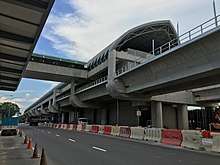
Construction on a new infill station Dover station between Buona Vista station and Clementi station began in June 1988. The building of the station was met with reservations by some members of the public over the small area it serviced and there were criticisms over the spending of "taxpayers' money" chiefly for use only by students of one educational institution.[11] Despite some opposition, the Land Transport Authority proceeded with the construction to serve commuters along Singapore Polytechnic with Dover housing estate.[12][13] On 18 October 2001, Dover was opened.[14] Prior to opening, test runs were conducted from 13 to 17 October 2001 when the trains stopped at this station but did not open their doors. Dover is the first station in the MRT network to be built as an infill station.[15]
The idea of extending the Mass Rapid Transit system to Changi Airport was reconsidered when Terminal 3 of the airport was being built.[16] Earlier plans had long been made for a new line branching off from the existing East West line at Tanah Merah,[17] with some conceptual plans showing a tentative route alignment up to the airport along Airport Boulevard, continuing beyond the airport to Changi Point, before turning southwest back towards the city along the eastern coasts. The plans were finally announced by then Deputy Prime Minister Lee Hsien Loong on 15 November 1996.[18] However, the new route alignment showed a deviation from previous plans[19][20], where the final plan involved in building only the first two stations of Expo, and Changi Airport, the latter being the underground station built between Terminal 2 and Terminal 3. The alignment of the station at the airport also switched perpendicularly to an east-west direction, such that the station leads to two of the terminals directly from either end of the station. The stations' designs were unveiled on 10 February 1998[21] with construction starting on 29 January 1999.[22] Expo and Changi Airport were opened on 10 January 2001 and 8 February 2002 respectively and currently operates under a shuttle service. Prior to 22 July 2003, train services from Boon Lay commences after the opening, but were later reverted to shuttle services due to low patronage.[23][24]. On 25 May 2019, it was announced that the Changi Airport Extension will be converted to become part of Thomson-East Coast line Extension (TELe) by 2040.[25]
The 3.8-kilometre (2.4 mi) Boon Lay extension was first announced by the LTA on 29 December 2004, set to serve residents from the Jurong West Town area and those working in the Jurong Industrial Estate.[26] The two stations, Pioneer and Joo Koon stations, officially opened on 28 February 2009.[27][28]
On 11 January 2011, the Tuas West extension, an extension of the East West line from Joo Koon to Tuas Link was announced. The extension has a span of 7.5 kilometres (4.7 mi), which spans a twin-tracked MRT viaduct, four above-ground stations and a 26-hectare depot to provide stabling and maintenance facilities for the additional trains that will be bought for the extension and to cater for future expansion of the line.[29] The viaduct is integrated with part of a 4.8-kilometre-long (3.0 mi) road viaduct along Pioneer Road, which will increase the road capacity to cope with anticipated increase in traffic. The stations are Gul Circle, Tuas Crescent, Tuas West Road, and Tuas Link. On 4 May 2012, the Land Transport Authority marked the start of construction of the Tuas West extension with a groundbreaking ceremony at the site of the future Tuas Link station.[30]
The extension began service on 18 June 2017.[31][32][33] During initial stages after opening, the westbound trains will alternate their terminus between Joo Koon and Tuas Link, where for every two trains, one train will terminate at the former, while the other train will terminate at the latter.[34]
Additional platform at Tanah Merah station
On 25 August 2014, the Land Transport Authority announced that a new platform will be constructed and added to Tanah Merah, enabling faster travel and shorter waiting times for commuters heading towards Expo and Changi Airport on the Changi Airport branch line of the East West line.[35]
On 26 October 2016, the Land Transport Authority awarded the civil contract to Lum Chang Building Contractors Pte. Ltd. to build a new platform at Tanah Merah and viaducts for a contract sum of S$325 million. In addition to the new platforms, the existing East West line tracks will be extended to connect the line to the new four-in-one East Coast Integrated Depot at Changi.[36] When completed in 2024, it will be the second station to have triple island platforms after Jurong East.
Half-height platform screen door installations
There were calls for platform screen doors (PSDs) to be installed at above-ground stations after several incidents in which passengers were killed or seriously injured by oncoming trains when they fell onto the railway tracks at above-ground stations. Underground stations already featured the doors since 1987. The authorities initially rejected the proposal by casting doubts over functionality and concerns about the high installation costs,[37] but made an about-turn later with the government announcing plans to install half-height platform screen doors on the elevated stations on 25 January 2008, citing lower costs due to its becoming a more common feature worldwide.[38] They were first installed at Jurong East, Pasir Ris, and Yishun stations in 2009 as trial runs.[39][40] On 31 August 2011, the LTA announced completion of the installation of PSDs along the East West line, with Expo being the last station on the line to receive the PSDs.[41] Installation of PSDs across both the North South and East West lines (NSEWL) were completed on 14 March 2012, 3 months ahead of schedule.[42]
Timeline of stations opened
- 12 December 1987: City Hall – Outram Park
- 12 March 1988: Outram Park – Clementi
- 5 November 1988: Clementi – Lakeside
- 4 November 1989: City Hall – Tanah Merah
- 16 December 1989: Tanah Merah – Pasir Ris
- 6 July 1990: Lakeside – Boon Lay
- 10 January 2001: Tanah Merah – Expo
- 18 October 2001: Dover
- 27 February 2002: Expo – Changi Airport
- 28 February 2009: Boon Lay – Joo Koon
- 18 June 2017: Joo Koon – Tuas Link
Improvement works
Timber to concrete sleeper replacement works
The timber sleepers on the East West line was required to be replaced as they were near the end of their 25-year lifespan. The replacement sleepers, made of concrete, have a significantly longer lifespan.[43] To speed up works, train services on the East West line was adjusted to end earlier. The work was divided into three phases: Phase 1 (Bugis - Tanah Merah), Phase 2 (Joo Koon - Jurong East, Tanah Merah - Pasir Ris) and Phase 3 (Jurong East - Outram Park). The sleepers were fully replaced on 18 February 2017.[44]
Re-signalling works
A new moving-block signalling system, supplied by Thales, replaced the former ageing fixed-block signalling system on the East West line. The new signalling system, costing $195 million, reduces waiting times for trains during peak periods from 120 seconds then to 100 seconds now.[45] The new system became operational between Pioneer and Tuas Link stations on 18 June 2017. Newer rolling stocks, such as the C151B and C151C, are equipped for use solely on the new signalling system.[46] Since 27 May 2018, the new signalling system has been operating full-day on the entire East West line.
Third-rail replacement
Replacement works on the third rail, which provides electricity to the trains, were carried out between September 2015 and August 2017.[47] The new third rail replaced its 30-year-old predecessor and is expected to increase reliability of the East West line's electrical system.[48]
Incidents
1993 Clementi train collision
On 5 August 1993, before opening, a maintenance vehicle spilt oil on the tracks between Clementi and Jurong East. The first ten eastbound trains reported braking problems, then the eleventh train from Jurong stopped at the Clementi station for two minutes longer than scheduled due to it using its emergency brakes to stop at the station at 7.50 am, before being hit by another eastbound train when it failed to stop in time. 156 passengers were injured by the collision.[49]
7 July 2015 Power trip
During the evening peak hours on 7 July 2015, services on both the East West and North South lines were temporarily disrupted due to massive power trips detected along the line. A cause of the disruption was damaged insulators which caused a failure to properly supply power.[50] For this disruption that brought inconvenience to 413,000 commuters, LTA imposed a 'record' fine of S$5.4 million on SMRT.[51]
22 March 2016 staff fatalities
At about 11.08 am on 22 March 2016, two SMRT track-maintenance trainee staff were killed after a C151 train approaching Pasir Ris station ran over them,[52], resulting in a temporarily service delay between Tanah Merah and Pasir Ris for about 2.5 hours and affected at least 10,000 commuters.[53]
In a report, the two trainee staff joined SMRT in January 2016 and worked as technicians under a technical team of 15 staff led by a supervisor and were tasked to go down to the tracks to investigate an alarm triggered by a possible signalling equipment fault close by the station. AN operator cited that they were granted access to the tracks, but did not coordinate with a Signal Unit in the station to ensure trains could not travel in the area where the team was.[54]
Patrick Nathan, SMRT vice-president, promised that "SMRT will review all safety protocols particularly those involving track access".[55] SMRT chief executive Desmond Kuek apologised for the incident and said SMRT will investigate how "the [two men] got hit by the train". SMRT fired both an engineer responsible for leading with the team and the train driver who was involved at the scene of the accident.
On 2 December 2016, SMRT was formally accused of failing to ensure that its employees complied with approved operating procedures when accessing the track; SMRT was then pleaded guilty to its charges on 28 February 2017 and incurred a S$400,000 fine.[56] Investigations are still ongoing against the two men, Teo Wee Kiat (SMRT's director of control operations) and Lim Say Heng, both charged for the incident.[57]
15 November 2017 train collision and delays
A second train collision occurred on 15 November 2017 at approximately 8.18am, where two C151A trains collided at Joo Koon MRT station. A train fault caused the first train heading in the direction of Tuas Link to stall at the station. A minute later, a second train stopped behind the first and then "moved forward unexpectedly" to cause the collision. 38 people, which include two SMRT staff were hospitalized.[58][59][60][61][62][63]
Train services between Tuas Link and Joo Koon stations were temporally suspended on both directions for two hours on the day itself and the entire day on 16 November 2017, resulting that the westbound trains would temporarily terminate at Joo Koon.[64][65]
An update by the Land Transport Authority (LTA) & SMRT on 16 November 2017 stated that LTA and SMRT have decided to isolate for up to one month the operations of the Tuas West extension, which runs on the new signalling system, from the rest of the East West line, which runs on the old signalling system, enabling LTA engineers to carry out further assurance checks together with Thales. The train was switching systems when the collision took place.[66] Train service on the line resumed on 20 November, with the Tuas West extension between Gul Circle and Tuas Link using the new signalling system and the section between Pasir Ris and Joo Koon, together with the Changi Airport Branch continuing to run on the old signalling system. Train services between Joo Koon and Gul Circle were temporarily suspended until its resumption on 28 May 2018; between the suspension a free bridging bus service is available between the two stations. Continuous service between Pasir Ris and Gul Circle resumed on 28 May 2018, with the permanent activation of the new CBTC system; since the incident, selected portions of either North South or East West line were to conduct track renewal works with early weekend closures and later station openings.[67]
Stations
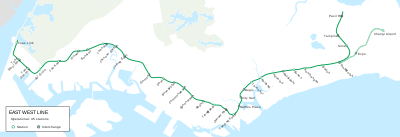

| Station Number | Station Name | Image | Interchange/Notes |
| EW1 CR5 CP1 | Pasir Ris | Interchange with the Cross Island line (2029) and Punggol Extension (2031) | |
| EW2 DT32 | Tampines |  | Connected to the Downtown line |
| EW3 | Simei |  | |
| EW4 CG | Tanah Merah |  | Cross-Platform Interchange with train services to Expo or Changi Airport stations.
Thomson-East Coast line (2040) after conversion of the Changi Branch line. Changi Branch line will be converted to become part of TELe by 2040.[68][69] |
| EW5 | Bedok | ||
| EW6 | Kembangan |  | |
| EW7 | Eunos |  | |
| EW8 CC9 | Paya Lebar |  | Interchange with the Circle line |
| EW9 | Aljunied |  | |
| EW10 | Kallang | ||
| EW11 | Lavender | ||
| EW12 DT14 | Bugis | Interchange with the Downtown line | |
| EW13 NS25 | City Hall | 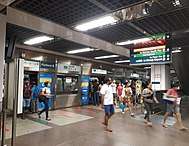 | Cross-Platform Interchange with the North South line |
| EW14 NS26 | Raffles Place |  | Cross-Platform Interchange with the North South line |
| EW15 | Tanjong Pagar |  | |
| EW16 NE3 TE17 | Outram Park |  | Interchange with the North East line and the Thomson-East Coast line (2021) |
| EW17 | Tiong Bahru | ||
| EW18 | Redhill | 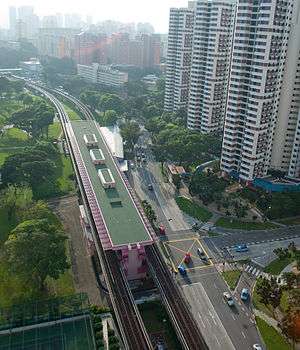 | |
| EW19 | Queenstown | ||
| EW20 | Commonwealth |  | |
| EW21 CC22 | Buona Vista |  | Interchange with the Circle line |
| EW22 | Dover |  | Infill station |
| EW23 | Clementi |  | |
| EW24 NS1 JE5 | Jurong East |  | Cross-Platform Interchange with the North South line Interchange with the Jurong Region line (2027) |
| EW25 | Chinese Garden |  | |
| EW26 | Lakeside |  | |
| EW27 JS8 | Boon Lay | 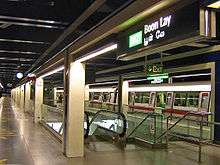 | Interchange with the Jurong Region line (2026) |
| EW28 | Pioneer | ||
| EW29 | Joo Koon | ||
| EW30 | Gul Circle |  | |
| EW31 | Tuas Crescent |  | |
| EW32 | Tuas West Road |  | |
| EW33 | Tuas Link |  | |
| Changi Airport line (CGL)
Service to be transferred to Thomson-East Coast line (under study, to be ready by 2040)[68][69] | |||
|---|---|---|---|
| CG1 DT35 | Expo |  | Interchange with the Downtown line |
| CG2 | Changi Airport | ||
SMRT used to operate the branch sector of Tanah Merah to Changi Airport as a through service from Boon Lay from 18 November 2001 until 22 July 2003, when it was replaced with a shuttle service. By 2040, the Changi Airport line (CAL) will be converted to the Thomson-East Coast line.[68][69]
Rolling stock


There are currently five models of rolling stock that operate on the East West Line. They are: The C151, the oldest rolling stock which was introduced in tandem with the opening of the line in 1987, along with the C651, C751B, C151A and the C151B which were introduced in the later years. These models of rolling stock were introduced to boost the capacity on both the North South and the East West lines in order to cope with increasing ridership.
The East West Line and the North South Line utilized identical rolling stock up until the recent years, when the C151A was temporary suspended from operating on the North South Line between January 2012 and November 2013 following the 2011 Train Disruptions. The C151B, which was introduced in April 2017, did not begin revenue service on the full-stretch of the EWL until the line's trial of the CBTC signalling system in May 2018. The C151C, which was introduced in September 2018, is currently operating on the North South Line only.
The CR151, will arrive in batches from 2021 and will gradually replace the first-generation C151 trains.[70][71][72]
These trains operate from the three depots along the line, the Ulu Pandan Depot between Jurong East and Clementi, the Changi Depot near Tanah Merah and the Tuas Depot located near Tuas Link.
Train control

The East West line is currently equipped with Thales SelTrac Communications-based train control (CBTC) moving block signalling system[73] with Automatic train control (ATC) under Automatic train operation (ATO) GoA 3 (DTO).[74] The subsystems consist of Automatic train protection (ATP) to govern train speed, NetTrac MT Automatic Train Supervision (ATS) to track and schedule trains and a Computer-based interlocking (CBI) system that prevents incorrect signal and track points to be set.[75]
The old signalling system has undergone decommissioning work from August 2018 and was completed on 23 November 2018.[76] It consists of Westinghouse fixed block signalling system with Automatic train control (ATC) under Automatic train operation (ATO) GoA 2 (STO)[77]. The subsystems consist of Automatic train protection (ATP) to govern train speed, Automatic Train Supervision (ATS) to track and schedule trains and a Relay interlocking system that prevents incorrect signal and track points to be set.
The stretch of track between Pioneer and Tuas Link stations was equipped with the new signalling system which came into use in June 2017. As the section of track between Pioneer and Joo Koon support 'mixed-mode' of both signalling systems, trains terminating at either Joo Koon or Tuas Link would have to change signalling modes at Pioneer MRT station as trains terminating at Joo Koon would proceed to a turn back siding which was built as part of the TWE which only supports the new signalling system. Eastbound trains towards Pasir Ris would have to change back to the old signalling system at Pioneer MRT station. This procedure was removed after the train collision at Joo Koon as trains terminated at Joo Koon. The new signalling system became fully operational on 28 May 2018.[67]
Automatic full-height platform screen doors by Westinghouse were originally installed in all underground stations since opening, and half-height platform screen doors by ST Engineering's Electronics sector were installed by August 2011 on elevated stations. Tuas West extension stations have half-height platform screen doors by Fangda from their opening.[78]
References
- "East-West Line". Singapore: Land Transport Authority. 29 January 2014. Retrieved 22 November 2014.
- Rav, Dhaliwal (12 December 1987). "Shopping for Xmas the MRT way..." Straits Times. Retrieved 19 September 2017 – via eResources.
- "Riding the MRT train to Clementi". The Business Times. 12 March 1988.
- "Road to be realigned for MRT". The Straits Times. 21 November 1984.
- "Three more stations for MRT system". The Business Times. 5 November 1988. Retrieved 16 June 2018 – via NewspaperSG.
- "On right track". The Straits Times. 4 November 1989.
- Dhaliwal, Rav (5 November 1986). "MRT Trains to Pasir Ris from Dec 16". The Straits Times.
- "MRT goes all the way east". The Straits Times. 17 December 1982.
- "Residents get sneak preview of three new MRT stations". The Straits Times. 15 December 1989.
- "Dr Yeo launches sale of commemorative tickets for the MRT". The Straits Times. 9 June 1990.
- Leong, Yit Chun (19 August 2002). "Public should not subsidise new MRT stations". The Straits Times Forum.
- "S'pore Poly to be linked to MRT". The Straits Times. 30 July 1997. p. 3.
- "Doorstep train". TODAY news. 5 October 2001. p. 8.
- Fook Kong, Lau (13 July 2001). "Next Stop: Dover". The Straits Times. p. 8.
- "Trial Runs at Dover". TODAY news. 13 October 2001. p. 6.
- "MRT extension to airport reconsidered". The Straits Times. 2 August 1994.
- "Next Stop: Changi Airport?". The New Paper. 2 August 1994.
- "Singapore Mass Rapid Transit Employees' Union (SMRTEU)'s annual Dinner and Dance" (PDF). NAS. 15 November 1996. Retrieved 10 July 2019.
- "MRT Line will not go beyond passenger terminals". The Straits Times. 12 December 1996. Retrieved 17 October 2019.
- "Changi Airport MRT line details". The Business Times. 12 December 1996. Retrieved 12 December 2017.
- "Changi Airport MRT station designed for travellers". The Straits Times (retrieved from NLB). 11 February 1998. Retrieved 29 December 2019.
- "Changi Airport Line Ground Breaking Ceremony". NAS. 29 January 1999. Retrieved 22 November 2019.
- "Boon Lay to Expo: MRT now running". The Straits Times. 20 December 2001.
- "Board MRT to airport from Tanah Merah". The Straits Times. 18 July 2003.
- "LTA to assess the feasibility of new rail line connecting northeast and south Singapore". CNA. 25 May 2019.
- "Expanding The Rail Network: LTA To Build Boon Lay MRT Extension". Land Transport Authority. 29 December 2004. Archived from the original on 13 May 2011.
- "Boon Lay Extension to Open in February 2009". LTA. 30 October 2008. Retrieved 6 September 2019.
- "Boon Lay MRT Extension". www.engleepl.com.sg. Retrieved 11 February 2020.
- "Speech (Part 1 – Public Transport) by Mr Lui Tuck Yew, Minister for Transport, for COS 2012". 7 March 2012. Archived from the original on 3 September 2012. Retrieved 12 August 2012.
- "Construction Starts for Tuas West extension" (Press release). Singapore: Land Transport Authority. 4 May 2012. Archived from the original on 2 February 2014.
- "Tuas West extension Opens on 18 June 2017" (Press release). Land Transport Authority. 27 April 2017.
- "Tuas West extension MRT stations to open Jun 18". Channel NewsAsia. Singapore. 27 April 2017.
- Lim, Kenneth (16 June 2017). "Opening of the Tuas West extension". Channel NewsAsia. Singapore.
- "Trains at 4 new stations on East-West Line's Tuas West extension to start plying on June 18". The Straits Times. Singapore. 5 June 2017.
- "New Platform at Tanah Merah MRT Station for Faster Travel to Expo and Changi Airport | Press Room | Land Transport Authority". www.lta.gov.sg. Retrieved 13 June 2017.
- "LTA Awards Civil Contract to Build A New Platform at Tanah Merah Station | Press Room | Land Transport Authority". www.lta.gov.sg. Retrieved 13 June 2017.
- "Safety at MRT and LRT Stations — Respect The Yellow Line" (Press release). Land Transport Authority. 20 November 2005. Archived from the original on 16 July 2012.
- "Platform screen doors for all above-ground MRT stations by 2012". The Straits Times. Singapore. 25 January 2008. Archived from the original on 28 January 2008.
- Yeo Ghim Lay (3 September 2008). "Platform doors for elevated MRT stations". The Straits Times. Singapore. p. 26.
- "Installation of Half Height Platform Screen Doors Pasir Ris Station". Land Transport Authority. 12 August 2009. Retrieved 26 May 2019.
- "Completion of Half Height Platform Screen Doors on East West Line" (Press release). Land Transport Authority. 31 August 2011. Retrieved 23 November 2015.
- "LTA completes installing elevated MRT station screen doors early". 14 March 2012. Retrieved 26 May 2019.
- "SMRT Rail Improvements – Updates – SMRT Blog". blog.smrt.com.sg. Retrieved 9 October 2017.
- Koh, Valerie (17 October 2015). "Phased early closure of East-West Line MRT stations from next month". Today. Singapore. Retrieved 3 March 2016.
- "LTA and SMRT Award Contracts for New Trains and Re-Signalling Project" (Press release). Land Transport Authority. 1 February 2012. Archived from the original on 26 July 2018. Retrieved 3 March 2016.
- Lim, Adrian (20 November 2015). "New MRT projects and upgrades to existing lines are on track, says LTA". The Straits Times. Singapore. Retrieved 3 March 2016.
- "FACTSHEET ON POWER RAIL REPLACEMENT PROGRAMME FOR THE NORTHSOUTH AND EAST-WEST LINES" (PDF). 12 September 2017. Archived from the original (PDF) on 23 September 2017. Retrieved 9 October 2017.
- "Third Rail Replacement of the North-South East-West Line". The SMRT Blog. 15 December 2015. Retrieved 3 March 2016.
- Singapore, National Library Board. "First MRT accident - Infopedia". eresources.nlb.gov.sg. Retrieved 13 March 2018.
- Malinda, Kyle (22 August 2015). "Cause of massive NSEWL train disruption in July identified, says SMRT". Channel NewsAsia. Singapore. Retrieved 3 March 2016.
- "SMRT to be fined a record S$5.4m for July 7 MRT breakdown". Channel NewsAsia. Singapore. 23 September 2015. Retrieved 3 March 2016.
- Seow Bei Yi; Lim, Adrian; Driscoll, Shea (23 March 2016). "SMRT accident: 2 men were part of group of 15 led by supervisor and walking facing oncoming train". The Straits Times. Singapore.
- "2 SMRT staff dead in accident near Pasir Ris station". Channel NewsAsia. Singapore. 22 March 2016. Retrieved 24 March 2016.
- "SMRT acknowledges safety procedure not followed before fatal accident". Channel NewsAsia. Singapore. 23 March 2016.
- Lee Min Kok; Seow Bei Yi; Lim, Adrian (23 March 2016). "2 SMRT Staff killed in MRT accident were Singaporeans aged 24 and 26 and undergoing on-the-job training". The Straits Times. Singapore.
- "SMRT fined S$400,000 over fatal accident".
- "SMRT, 2 others charged over fatal track accident". The Straits Times. 2 December 2016.
- "Joint Statement by the Land Transport Authority (LTA) & SMRT - Joo Koon train incident". Land Transport Authority. 15 November 2017.
- "Joint Statement by the Land Transport Authority (LTA) & SMRT - Update on Joo Koon train incident". Land Transport Authority. 15 November 2017.
- "Update on Train Incident at Joo Koon Station". Land Transport Authority. 15 November 2017.
- "MRT train collides with stationary train at Joo Koon station: Reports". Channel NewsAsia. Retrieved 15 November 2017.
- hermesauto (15 November 2017). "SMRT train hits stationary train at Joo Koon MRT station; passengers taken to hospital". The Straits Times. Retrieved 15 November 2017.
- "Second train delay hits EWL commuters on Wednesday morning". Retrieved 15 November 2017.
- "Train service between Joo Koon and Tuas Link stations suspended". Channel NewsAsia. 15 November 2017.
- "Train service between Joo Koon, Tuas Link stations to be suspended on Thursday". The Straits Times. 15 November 2017.
- "Update on Train Services on Tuas West extension". Land Transport Authority. 16 November 2017.
- hermesauto (28 May 2018). "East-West Line running on new signalling system now - all the way to Tuas West and back". The Straits Times. Retrieved 8 July 2018.
- "Land Transport Master Plan 2040: Bringing Singapore Together | Press Room | Land Transport Authority". Land Transport Authority. Retrieved 26 May 2019.
- "At a glance: Key updates to MRT, bus network and more for 2040 master plan". TODAYonline. 25 May 2019.
- "LTA | News Room | News Releases | Bombardier to Supply 66 New Trains for North-South and East-West Lines". www.lta.gov.sg. Retrieved 8 February 2020.
- "New fleet to replace 66 oldest MRT trains from 2021". Channel NewsAsia. Retrieved 25 July 2018.
- hermesauto (25 July 2018). "Bombardier awarded $1.2 billion contract to replace 66 oldest MRT trains". The Straits Times. Retrieved 25 July 2018.
- "Thales awarded signalling contracts for Singapore North-South, East-West lines and Tuas West Extension | Thales Group". www.thalesgroup.com. Archived from the original on 20 August 2017. Retrieved 4 July 2017.
- http://www.uitp.org/sites/default/files/Metro%20automation%20-%20facts%20and%20figures.pdf
- "Thales awarded signalling contracts for Singapore North-South, East-West lines and Tuas West Extension" (Press release). Thales Group. 6 February 2012. Archived from the original on 30 June 2015.
- "New MRT signalling system to be trialled on EWL for 5 Sundays from Apr 29". Channel NewsAsia. Retrieved 27 May 2018.
- Woodland, Daniel (August 2004). "Optimisation of Automatic Train Protection Systemstion Systems" (PDF). p. Appendix C Page 32 to Page 33. Archived (PDF) from the original on 16 June 2020. Retrieved 15 June 2020.
- "Tuas West Extension - Platform Screen Doors supplied by Fangda - Land Transport Guru". 21 June 2017. Retrieved 13 March 2018.

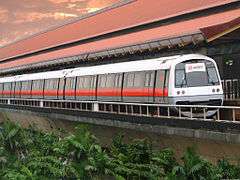
.jpg)